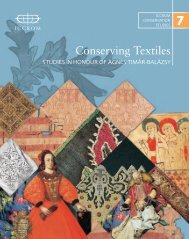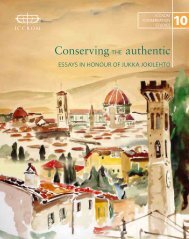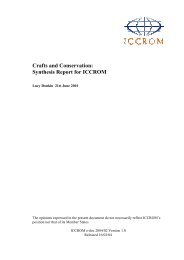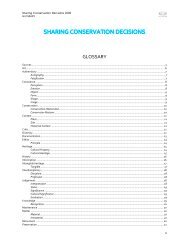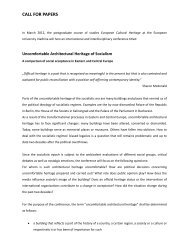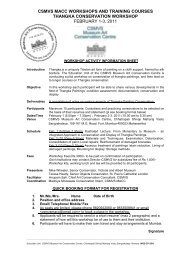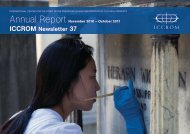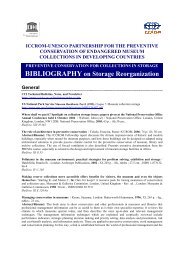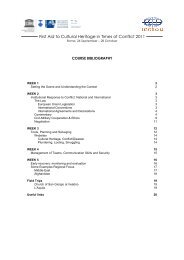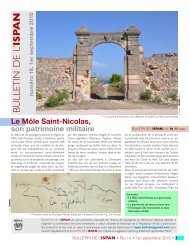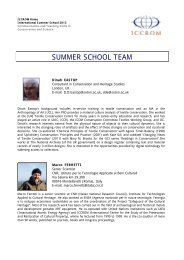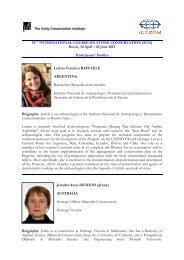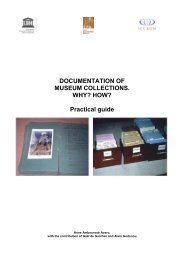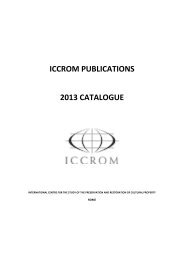part 1 - Iccrom
part 1 - Iccrom
part 1 - Iccrom
Create successful ePaper yourself
Turn your PDF publications into a flip-book with our unique Google optimized e-Paper software.
MEASURING HERITAGE CONSERVATION PERFORMANCE<br />
6th International Seminar on Urban Conservation<br />
on its nonmaterial cultural values, they are reviewed<br />
separately.<br />
4.1. Assessing the conservation of the fabric<br />
The assessment and monitoring of conservation<br />
processes and materials that aim to preserve the<br />
fabric of cultural heritage have been long-standing<br />
concerns for conservation practitioners. For this<br />
reason, much data have been generated relating to<br />
the appropriateness of conservation materials and<br />
methods of intervention. It is without any doubt the<br />
most developed area of assessment, though it lacks<br />
standardized indicators due to the large variety of<br />
materials, types of decay and conservation processes<br />
to be recorded and monitored.<br />
Some ranks and standards for the ‘ideal’ or ‘optimum’<br />
conservation of heritage materials have been<br />
defined over time (Alcántara, 2002), with numerous<br />
publications indicating the results of very elaborate<br />
research mainly focused on museum and archive<br />
collections, but systematic approaches for the evaluation<br />
and monitoring of processes and methods (and<br />
their results) are still incipient (World Heritage Centre<br />
/ ICCROM, 2002).<br />
It is also worth mentioning that the relevance of<br />
conserving the fabric varies across cultures, since<br />
some cultures prioritize nonmaterial values over the<br />
conservation of the fabric. Perhaps one of the most<br />
disseminated examples is the rebuilding practices<br />
of Shinto shrines in Japan. In these shrines what is<br />
actually maintained is the tradition and construction<br />
know-how rather than the material itself, since<br />
buildings are demolished and reconstructed every<br />
20 years (Brock-Nannestad, 2000, p. 30; Inaba, 2005)<br />
according to the Shinto belief about the renewal of<br />
nature. Examples from other <strong>part</strong>s of the world were<br />
clearly shown in ICCROM’s Forum on living religious<br />
heritage (Stovel et al., 2005).<br />
Due to the degree of development of this area, as<br />
well as the variety of materials and conservation<br />
processes involved, this aspect is not analysed in<br />
detail here. The reader is advised to consult relevant<br />
work on remedial and preventive conservation, such<br />
as Appelbaum (2007), Matteini and Moles (2003),<br />
Roy and Smith (1994) and Adelstein (2004) as well as<br />
on monitoring (World Heritage Centre – ICCROM,<br />
2002).<br />
The overall trend is to recommend the use of a combination<br />
of identifiable and measurable elements,<br />
and accurate documentation techniques, so that<br />
evaluations can be repeated over time.<br />
4.2. Assessing the conservation of<br />
nonmaterial cultural values<br />
Due to the scientific approach that has characterized<br />
conservation practice in the last decades and<br />
the consequent predominant emphasis on the material<br />
fabric of heritage, assessing the conservation<br />
and enhancement of nonmaterial cultural values has<br />
often been overlooked. This has also been the result<br />
of an approach focusing on monuments and art collections<br />
that was developed in Western traditions. In<br />
this sense, the Nara Document (Lemaire and Stovel,<br />
1994), the Burra Charter (ICOMOS Australia, 1999)<br />
and the Convention for the Safeguarding of Intangible<br />
Cultural Heritage (UNESCO, 2003) constitute important<br />
theoretical baseline knowledge in the formulation<br />
of a wider understanding of cultural heritage<br />
and for developing approaches that consider nonmaterial<br />
cultural values (Wijesuriya et al., 2006).<br />
The World Heritage Committee and various<br />
national heritage institutions have carried out assessments<br />
of cultural significance in order to decide<br />
whether a <strong>part</strong>icular building, site or landscape can<br />
be inscribed on heritage lists, <strong>part</strong>icularly the World<br />
Heritage List. In the same way, a common practice<br />
in conservation is to formulate a statement of significance<br />
that incorporates the values surrounding<br />
cultural heritage, and subsequently formulate<br />
the conservation proposal based on that statement.<br />
Unfortunately, however, conservation projects do<br />
not usually carry out these types of assessments<br />
after conservation activities take place, assuming<br />
that interventions do not change cultural significance<br />
and that only the assessment of the fabric is<br />
worth documenting, assessing and monitoring after<br />
conservation interventions.<br />
Nonetheless, it is clear that conservation activities<br />
modify the way we interpret and value objects, landscapes<br />
and sites (Lemaire and Stovel, 1994, p. 2; Getty<br />
Conservation Institute, 2000, p. 8), and therefore<br />
conservation has an important impact on heritage’s<br />
cultural significance. A clear example is the cleaning<br />
of Michelangelo’s paintings of the Sistine Chapel at<br />
the Vatican. In this case, regardless of whether the<br />
cleaning processes did or did not remove original<br />
materials, the conservation intervention generated<br />
a huge controversy that had a tremendous impact<br />
on how the public and art specialists perceive these<br />
paintings (see Eliot, 1987; González Tirado, 2010),<br />
which modifies the values and the cultural significance<br />
attached to them.<br />
The assessment of cultural significance is <strong>part</strong>icularly<br />
relevant for living heritage, due to the crucial<br />
Alonso, V. I. & V. M. Meurs. 2012. Assessing the performance of conservation activities. In Zancheti, S. M. & K. Similä, eds. Measuring<br />
heritage conservation performance, pp. 1-14. Rome, ICCROM.<br />
4



